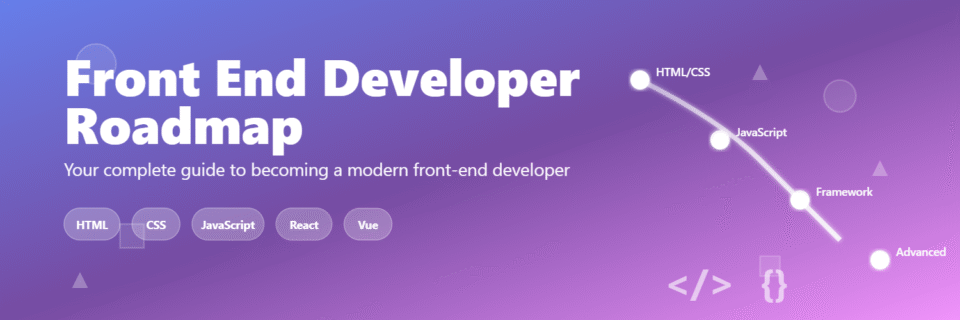The Complete Front End Developer Roadmap 2025: Your Guide to Modern Web Development
Front end development has evolved dramatically over the past decade, transforming from simple HTML pages to complex, interactive applications that power the modern web. Whether you’re a complete beginner or looking to advance your existing skills, this comprehensive roadmap will guide you through every stage of becoming a proficient front end developer.
Understanding Front End Development
Front end development focuses on creating the user-facing part of web applications – everything users see and interact with in their browsers. Front end developers bridge the gap between design and functionality, translating visual designs into interactive, responsive, and accessible web experiences.
Front End Developer Roadmap
Phase 1: Foundation Skills (Months 1-3)
HTML: The Structure of the Web
HTML (HyperText Markup Language) forms the backbone of every webpage. Master these fundamentals:
Essential HTML Concepts:
- Semantic HTML5 elements (header, nav, main, section, article, aside, footer)
- Forms and input validation
- Accessibility attributes (ARIA labels, roles, properties)
- Meta tags for SEO and social sharing
- HTML5 APIs (Local Storage, Geolocation, Canvas)
Best Practices:
- Use semantic markup for better accessibility and SEO
- Validate your HTML using W3C validators
- Implement proper heading hierarchy
- Optimize images with appropriate alt text and formats
CSS: Styling and Layout
CSS transforms plain HTML into visually appealing interfaces. Progress through these areas:
Core CSS Skills:
- Selectors, specificity, and the cascade
- Box model and positioning
- Flexbox and CSS Grid for modern layouts
- Responsive design with media queries
- CSS animations and transitions
- Custom properties (CSS variables)
Modern CSS Features:
- Container queries for component-based responsive design
- CSS Grid subgrid for complex layouts
- Logical properties for international compatibility
- CSS custom properties with fallbacks
- Modern color functions (oklch, color-mix)
CSS Preprocessors:
- Sass/SCSS for variables, mixins, and nesting
- PostCSS for modern CSS features and optimization
JavaScript: Bringing Pages to Life
JavaScript adds interactivity and dynamic behavior to web pages.
JavaScript Fundamentals:
- Variables, data types, and operators
- Functions, scope, and closures
- Objects and arrays
- Control flow (if/else, loops, switch)
- Error handling with try/catch
- Asynchronous programming (callbacks, promises, async/await)
DOM Manipulation:
- Selecting and modifying elements
- Event handling and delegation
- Creating and removing elements dynamically
- Working with forms and user input
Modern JavaScript (ES6+):
- Arrow functions and template literals
- Destructuring assignment
- Modules (import/export)
- Classes and inheritance
- Spread and rest operators
- Map, Set, and other built-in objects
Front End Developer Roadmap
Phase 2: Intermediate Development (Months 4-8)
Version Control with Git
Git is essential for tracking code changes and collaborating with others:
- Repository management (init, clone, remote)
- Branching strategies (Git Flow, GitHub Flow)
- Merging, rebasing, and conflict resolution
- Working with GitHub/GitLab/Bitbucket
- Pull requests and code reviews
CSS Frameworks and Libraries
While understanding vanilla CSS is crucial, frameworks accelerate development:
Utility-First Frameworks:
- Tailwind CSS for rapid prototyping
- Understanding utility classes vs. component-based CSS
Component Libraries:
- Bootstrap for quick responsive layouts
- Material-UI or Ant Design for React projects
- Chakra UI for modern component systems
JavaScript Build Tools and Package Management
Modern development requires understanding the tooling ecosystem:
Package Managers:
- npm for package installation and script management
- Yarn as an alternative package manager
- Understanding package.json and semantic versioning
Build Tools:
- Webpack for bundling and asset optimization
- Vite for fast development and building
- Parcel for zero-configuration building
- Rollup for library bundling
Development Tools:
- ESLint for code linting and consistency
- Prettier for code formatting
- Husky for Git hooks and pre-commit checks
Frontend Frameworks and Libraries
Choose one framework to master deeply before exploring others:
React Ecosystem:
- Component lifecycle and hooks
- State management with useState and useReducer
- Context API for global state
- React Router for navigation
- Popular libraries (React Query, Formik, React Hook Form)
Vue.js Ecosystem:
- Vue 3 composition API
- Vuex or Pinia for state management
- Vue Router for single-page applications
- Vue CLI and Vite for project setup
Angular Framework:
- TypeScript integration
- Components, services, and dependency injection
- RxJS for reactive programming
- Angular CLI for project management
Front End Developer Roadmap
Phase 3: Advanced Concepts (Months 9-12)
State Management
As applications grow complex, proper state management becomes crucial:
React State Management:
- Redux Toolkit for predictable state updates
- Zustand for lightweight state management
- Jotai for atomic state management
Vue State Management:
- Pinia as the modern Vuex alternative
- Composables for shared state logic
General Patterns:
- Flux architecture principles
- Immutability and pure functions
- Middleware and side effects handling
Testing
Quality assurance through comprehensive testing:
Unit Testing:
- Jest for testing JavaScript functions
- React Testing Library for component testing
- Vue Test Utils for Vue component testing
Integration Testing:
- Testing API integrations
- Testing user workflows
- Mocking external dependencies
End-to-End Testing:
- Cypress for full application testing
- Playwright for cross-browser testing
- Puppeteer for headless browser automation
Performance Optimization
Creating fast, efficient applications:
Core Web Vitals:
- Largest Contentful Paint (LCP)
- First Input Delay (FID)
- Cumulative Layout Shift (CLS)
Optimization Techniques:
- Code splitting and lazy loading
- Image optimization and responsive images
- Caching strategies (service workers, HTTP caching)
- Bundle analysis and tree shaking
- Critical CSS and above-the-fold optimization
TypeScript Integration
Adding type safety to JavaScript projects:
- Basic types and interfaces
- Generics and utility types
- Integration with React/Vue/Angular
- Type definitions for third-party libraries
- Advanced types and conditional types
Front End Developer Roadmap
Phase 4: Professional Development (Months 12+)
Advanced Tooling and Workflow
Continuous Integration/Deployment:
- GitHub Actions for automated testing and deployment
- Netlify, Vercel, or AWS for hosting
- Docker for containerization
- Environment configuration and secrets management
Monitoring and Analytics:
- Error tracking with Sentry or Rollbar
- Performance monitoring with Lighthouse CI
- User analytics integration
- A/B testing implementation
Accessibility and Inclusive Design
Creating applications for all users:
- WCAG guidelines and compliance
- Screen reader compatibility
- Keyboard navigation support
- Color contrast and visual accessibility
- Semantic HTML for assistive technologies
Progressive Web Applications (PWAs)
Building app-like experiences for the web:
- Service workers for offline functionality
- Web app manifests
- Push notifications
- Background sync
- Performance optimization for mobile
Micro-Frontends Architecture
Scaling applications with micro-frontend patterns:
- Module federation with Webpack
- Independent deployment strategies
- Shared component libraries
- Communication between micro-frontends
Emerging Technologies and Trends
Web Components
Creating reusable, framework-agnostic components:
- Custom elements and shadow DOM
- Lit framework for building web components
- Stencil for component compilation
WebAssembly (WASM)
Running high-performance code in browsers:
- Understanding WASM capabilities
- Integrating WASM modules with JavaScript
- Performance-critical use cases
AI Integration
Incorporating AI and machine learning:
- TensorFlow.js for client-side ML
- OpenAI API integration
- AI-powered development tools
- Automated testing with AI
Learning Resources and Path
Online Platforms
- FreeCodeCamp for comprehensive tutorials
- MDN Web Docs for authoritative documentation
- Frontend Masters for advanced courses
- Pluralsight and Udemy for structured learning
Practice Projects
- Build a personal portfolio website
- Create a todo application with your chosen framework
- Develop a weather app using external APIs
- Build an e-commerce product page
- Create a real-time chat application
Community Engagement
- Join developer communities (Dev.to, Reddit, Discord)
- Attend local meetups and conferences
- Contribute to open-source projects
- Follow industry leaders on social media
Specialization Areas
After mastering the fundamentals, consider specializing in:
UI/UX Development:
- Design systems and component libraries
- Animation and micro-interactions
- User research and usability testing
Performance Engineering:
- Core Web Vitals optimization
- Advanced caching strategies
- Critical rendering path optimization
Mobile Development:
- React Native or Flutter for cross-platform apps
- Progressive Web App optimization
- Mobile-first design principles
Developer Experience:
- Build tool development
- CLI tool creation
- Documentation and tooling
Career Progression
Junior Developer (0-2 years)
- Master HTML, CSS, and JavaScript fundamentals
- Learn one framework thoroughly
- Build personal projects and contribute to open source
- Focus on writing clean, maintainable code
Mid-Level Developer (2-4 years)
- Understand architectural patterns and best practices
- Lead small projects and mentor junior developers
- Contribute to technical decisions
- Develop expertise in testing and performance
Senior Developer (4+ years)
- Design system architecture and technical strategy
- Mentor teams and lead technical initiatives
- Stay current with industry trends and emerging technologies
- Contribute to open-source projects and technical writing
Front End Developer Roadmap
Conclusion
The front end development landscape continues evolving rapidly, with new frameworks, tools, and best practices emerging regularly. Success in this field requires continuous learning, practical application, and staying connected with the developer community.
Remember that becoming proficient takes time and consistent practice. Focus on building a strong foundation before moving to advanced topics, and always prioritize understanding concepts over memorizing syntax. The most successful developers are those who can adapt to new technologies while maintaining solid fundamentals.
Start with small projects, gradually increase complexity, and don’t hesitate to seek help from the community. The journey of front end development is challenging but rewarding, offering endless opportunities for creativity and problem-solving in the digital world.
Front End Developer Roadmap
Table of Contents
Front End Developer Roadmap
Front End Developer Roadmap

Front End Developer Roadmap




2 comments
[…] Front End Developer Roadmap […]
[…] Front End Developer Roadmap […]